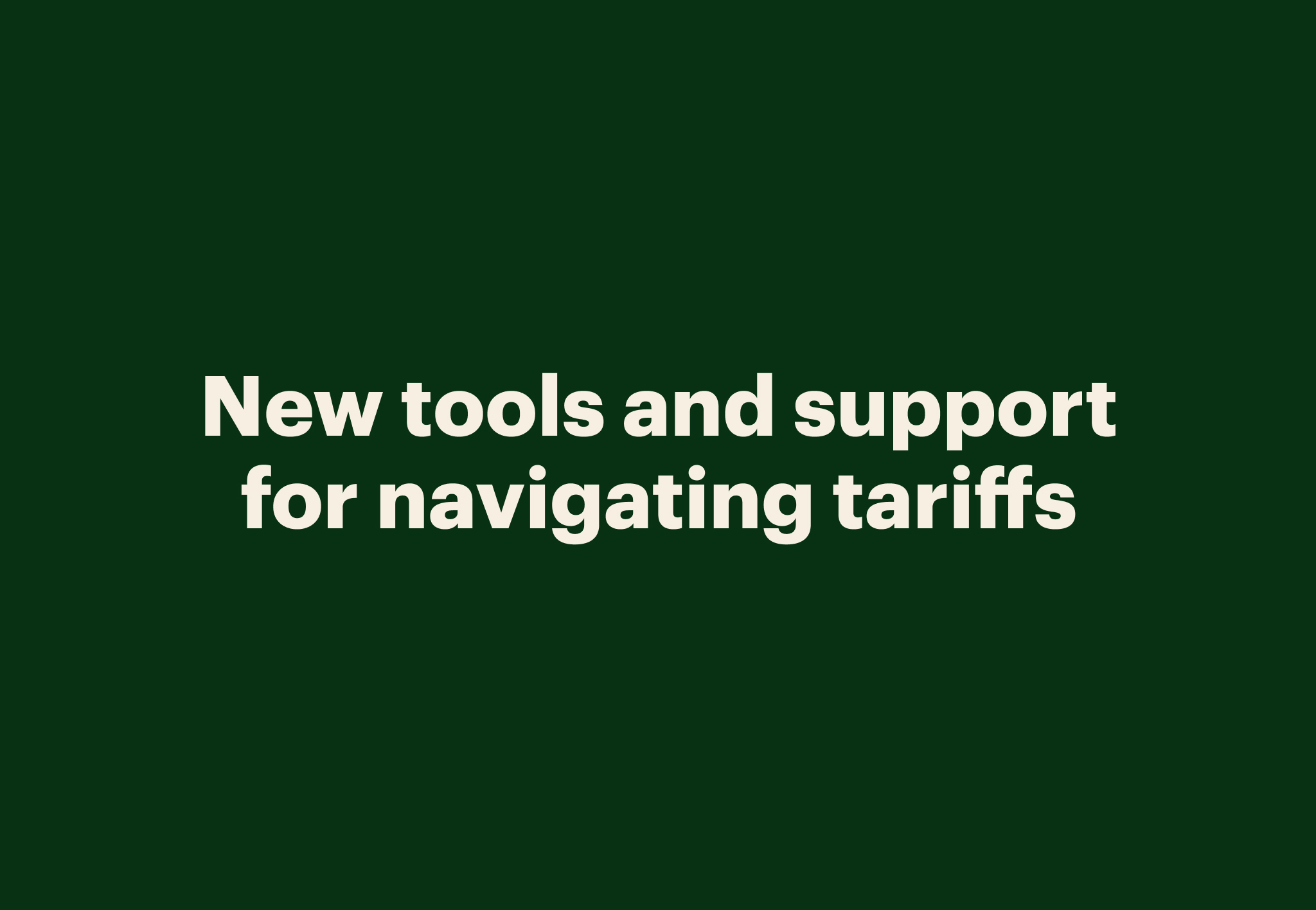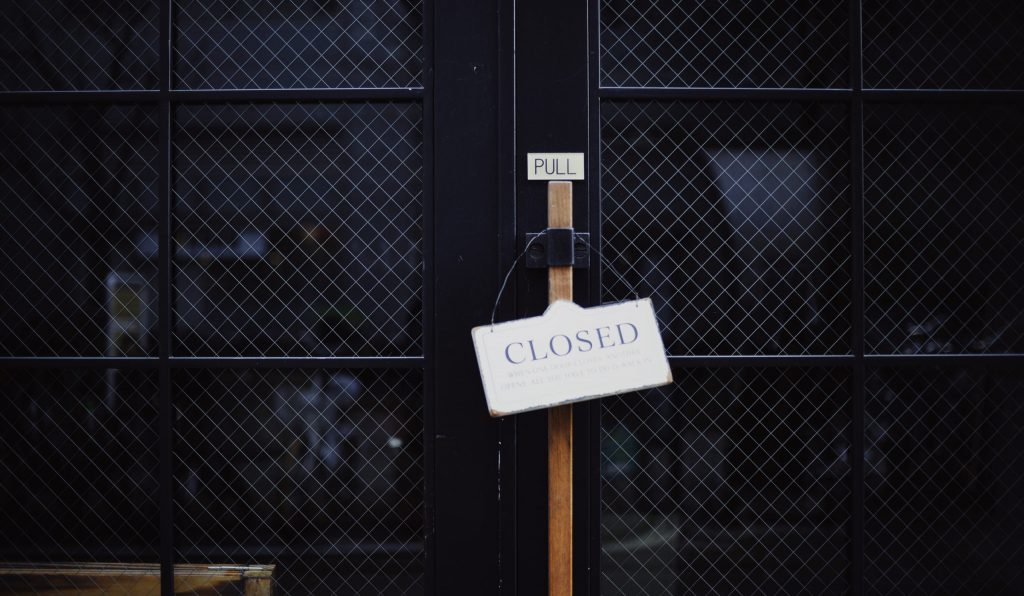
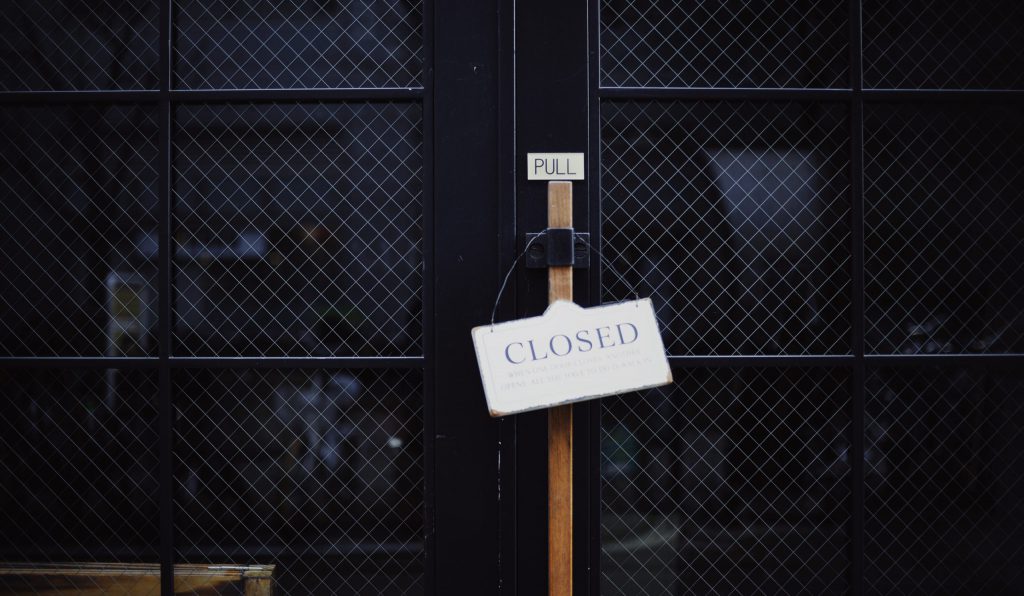
There is no denying it—the COVID-19 crisis is a once-in-a-lifetime event. The overall timeline and economic impact of this disruption remains uncertain, and developments are rapidly changing. The stakes are high, and how we respond now will determine how our communities recover.
We’re in this together
From the beginning, we’ve built Faire on the belief that the future is local. Our mission is to empower entrepreneurs to chase their dreams, and we’ll continue to operate that way through this critical time. Our team of experts has put together this comprehensive resource of all the information currently available to us, in order to help you make informed decisions for your business.
We’ll continue to update this page with helpful insights, relevant data, and new tools we’re building to empower your decision-making as you prepare for a full recovery.
What we’ve learned
This week, we surveyed more than 20,000 retailers and makers to hear how you have responded to the crisis. We’ll continue surveying 20,000 more retailers and makers each week, and we’ll share how things are changing over time.
Key survey takeaways
- 70% of independent retailers report not having enough cash on hand to handle this type of crisis
- 64% of retailers have already started reducing inventory purchases
- Retailers are expecting a temporary revenue reduction of 50% or more, depending on local public health policies
The impact for retailers is serious
70% of retailers say that they don’t have enough cash on hand to handle a crisis like this. Of those that do have capital accessible, most retailers (54%) have 3 months or less of operating expenses. That’s 3 months of cash run rate without sales, meaning millions of small businesses could face bankruptcy this quarter without taking immediate action.
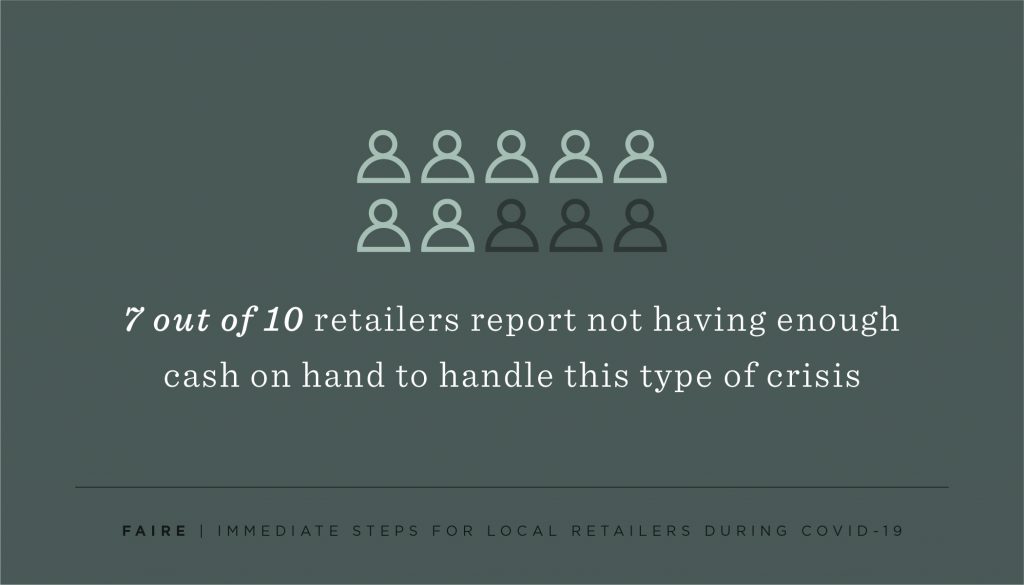
The highest impact areas for stores right now include decreased sales, voluntary or forced store closures, and trade show cancellations and/or vendor disruptions. Our initial data shows retailers are expecting a temporary revenue reduction of 50% or more, depending on local public health policies.
Retailers are finding new solutions
64% of retailers surveyed have already started reducing inventory purchases, and hopefully more will follow suit. 25% have started investing more in existing online sales channels, and 19% (so far) have started investing in new online channels. Retailers of all sizes and categories are starting to find ways to reduce costs and create new revenue streams.
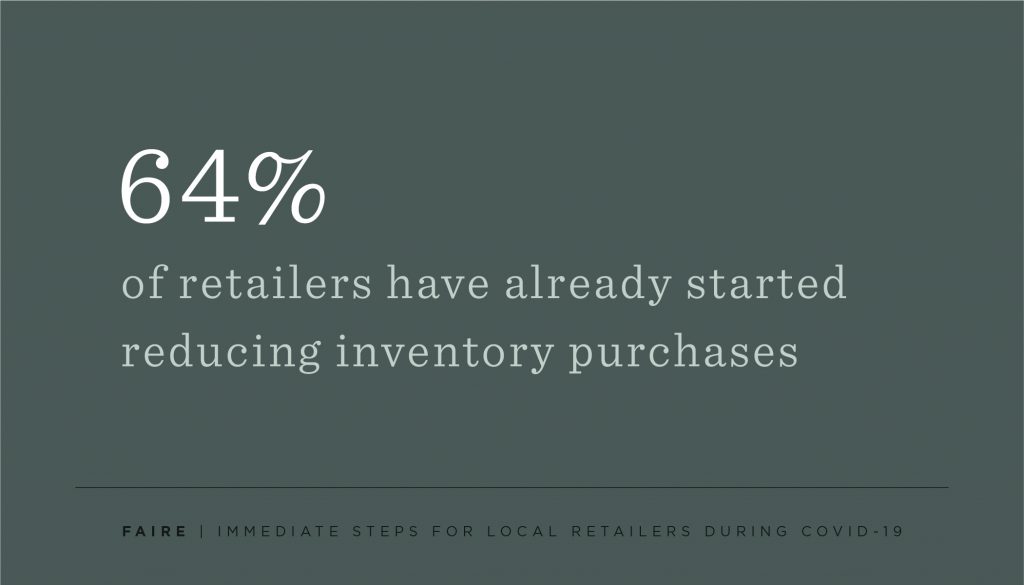
Community building is essential
The Shop Local community has been built on the power of human connection. 67% of retailers have already reached out to their customers directly about COVID-19. As for the retailer community, only 47% of retailers have connected with other local businesses so far.
The most common response to what retailers are expecting business to look like over the next 3 months is “I don’t know.” Staying in touch, sharing learnings and resources, and communicating in community forums will help this community stay informed and resilient through this time.
Steps to take today
1. Prioritize health
Listen to the experts when it comes to creating a healthy work environment. Here are some immediate steps and trusted resources you can count on.
- Protect yourself and others, above all else. Actively encourage sick employees to stay home, practice social distancing, and follow the latest updates on the CDC’s website.
- Follow guidance from your state and local government, and understand any local restrictions on travel or commerce. Get more info from the chamber of commerce in your state and from your local Small Business Administration (SBA) office.
- Disinfect your store thoroughly and frequently. Consider adjusting your hours of operation to provide ample time to disinfect all surfaces in your store. Also, encourage customers to avoid touching items while browsing.
2. Reduce your costs
There are several levers you can pull to find ways to reduce your business’s costs.
- First, assess your overall financial picture. Understanding your costs and available capital can help you make informed decisions on where to cut down.
- Renegotiate your rent. Talk with your landlord about rent concessions, forgiveness, or delays until things have stabilized. You may be able to come to a good solution.
- Reduce your inventory purchases immediately. Buy fewer products, including from Faire. While it may seem odd for us to be telling you to shop less with us, it’s some of the best advice we can give you to conserve your cash and shore up your business for the future.
- Reduce software providers to one-time payments. Look at your accounts and see if you can move to more basic plans. Also, reduce or cut advertising spending you may have ongoing.
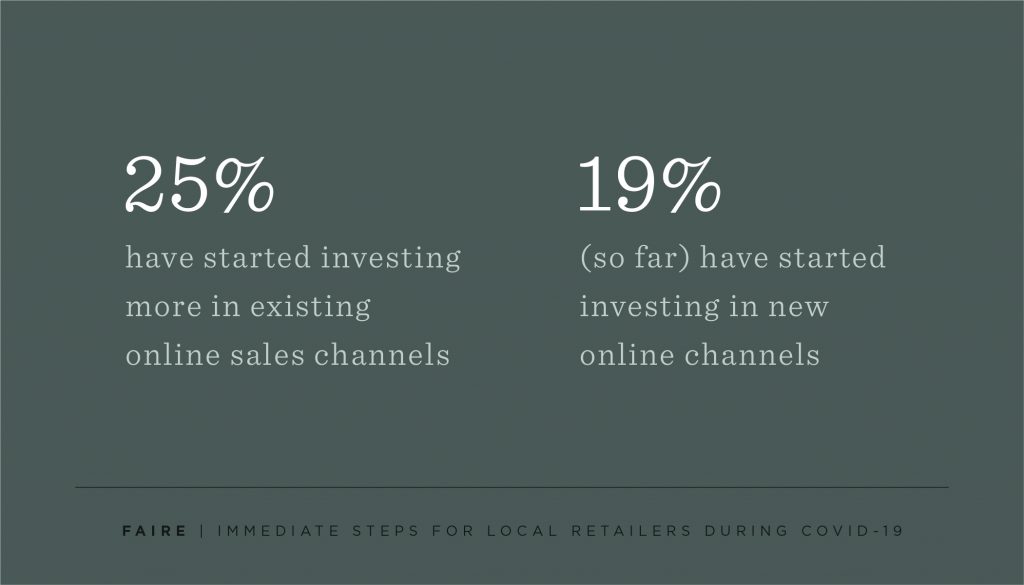
3. Do the right thing for your people & your business
Making decisions about your staff may be the hardest decision you face during this time. When assessing your options, consider what’s best for the health of your business and your people.
- Paid sick leave: Congress passed a subsidy for up to two weeks paid sick leave, where employers will be reimbursed in the form of tax credits. This begins April 2 for firms under 500 people. Read more here.
- Reduce your salary costs. Consider making necessary salary cuts across the board, reducing working hours, or making personnel decisions you believe are best for the future of your business.
- Share unemployment benefit resources with your employees, if you do decide to make tough calls regarding your team. Several states are increasing access to benefits during this time. Learn more from the U.S. Department of Labor.
- Check-in with your insurance broker to understand your policy’s coverage. We can’t give you insurance or any legal advice, so reach out to your broker to understand your policy. Every policy is different, and many policies may require physical loss or damage for coverage. However, reaching out to your broker to see if you should file a claim is the right first step to know what’s right for you.
4. Seek financial relief & credit options
Potential relief is out there. Federal, state, and local governments, along with private entities, are announcing new options frequently for qualifying businesses. Continue to check for relief that may make sense for you.
- Congress and the White House passed a $2 trillion stimulus package in response to the COVID-19 outbreak. The package, known as the “CARES Act,” will open up new small business loans for many retailers and makers that need support during this difficult period. Read more here and start applying for relief funding.
- Look for new credit lines and access to capital. We have created this spreadsheet with the latest list of resources available by state. You can check what programs are available to you through your chamber of commerce and local Small Business Administration (SBA) office.
- $7 billion in loans for disaster relief have been authorized to be issued by the SBA. With this, the SBA can provide up to $2 million in disaster loans to pay fixed debts, payroll, accounts payable, and other bills that can’t be paid because of COVID-19. Check the SBA website to see if your area has been declared eligible for disaster loan assistance.
- Companies like Facebook are offering cash grants for small businesses that are worth exploring.
- Email covid-relief@faire.com if you know other available loan programs, and we’ll review them and share updates frequently.
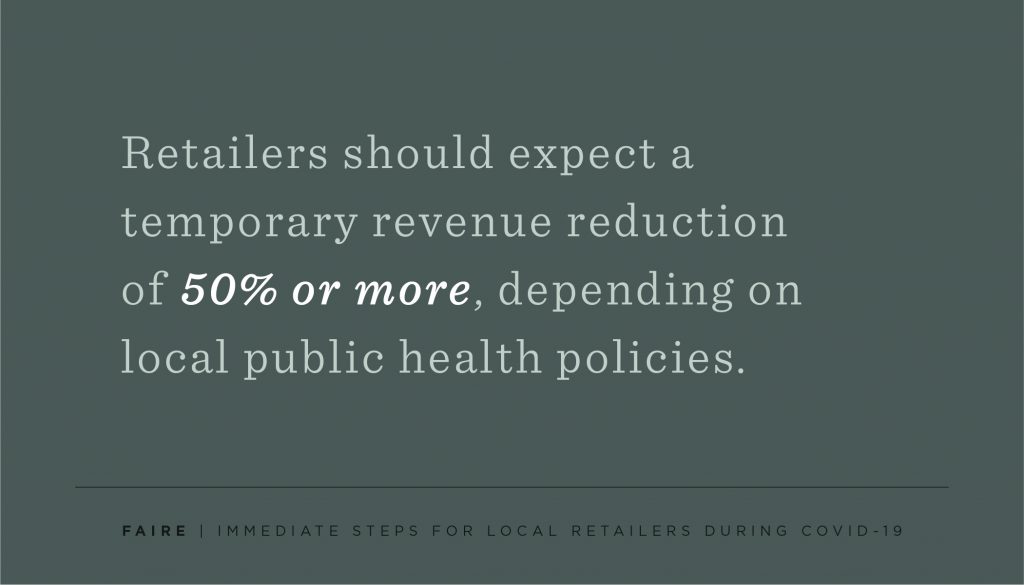
5. Increase your revenue
Consumer shopping behaviors are changing, and essentials are in demand while people stay home with their families. Here are some ways to support your customers in their time of need.
- Stock up on essentials for your customers. From pantry staples to cleaning supplies, consider carrying more essential items that you can deliver or sell to your customers.
- Discount underperforming inventory. With demand for non-essential retail likely decreasing, your inventory could become deadstock. Now is the time to make sure you aren’t sitting on cash held up in inventory, especially if you are physically open and think you may temporarily close for COVID-19. Consider discounts, bundles, or other tactics.
- Deliver products directly to customers, instead of having them come to your store. Other models that retailers are using to maintain healthy social distancing include hosting virtual personal shopping through social media and offering curbside pickup.
- Promote your store’s website and online presence. If you don’t have a website, consider selling through platforms like Shopify or Square, who make it easy to create one.
- Pre-sell gift cards to existing customers, or set up e-gift cards with Square.
6. Stay informed on economic developments
The projected impact of COVID-19 is changing day-to-day. Stay informed of the latest developments and advice from authorities.
- The U.S. government is planning for 18 months or longer of impact from COVID-19. McKinsey suggests that the economy will either take 6 months until Q4 in a “delayed recovery” or 12 months until Q2 2021 in a “prolonged contraction”. JP Morgan performed analysis that suggests that we may enter a recession in the next 6 months and then recover in the second half of the year.
- We’ve learned from patterns emerging in China. China’s lockdown restrictions lasted roughly 2 months, with slow recovery happening now. According to FedEx, “closer to 65% to 70% of small businesses in Mainland China are coming back to work from a manufacturing perspective.” We’re continuing to monitor the information from China, and March retail sales data will confirm if this recovery is flowing through to economic output.
- The economic impact on local retail may be a decrease of 10-70% of sales for some time. “Shelter at home” policies and other restrictions are likely to drop sales to near 0% in urban areas, aside from essential goods.
7. Connect with your customers & community
Engage with your customers and learn from others in the industry.
- Create community with your customers. We’ve heard about lots of creative online hangouts, including setting a daily time when customers can have coffee virtually with other store patrons. Use social media, email, and other means of direct communication in a way that feels authentic to you—it’s time to get creative!
- Join our retailer Facebook forum to share information and learn more from your peers in the industry.
- Reach out to local and state officials to advocate for your needs. Find your local representatives and fight for American relief efforts to help local communities and small businesses.
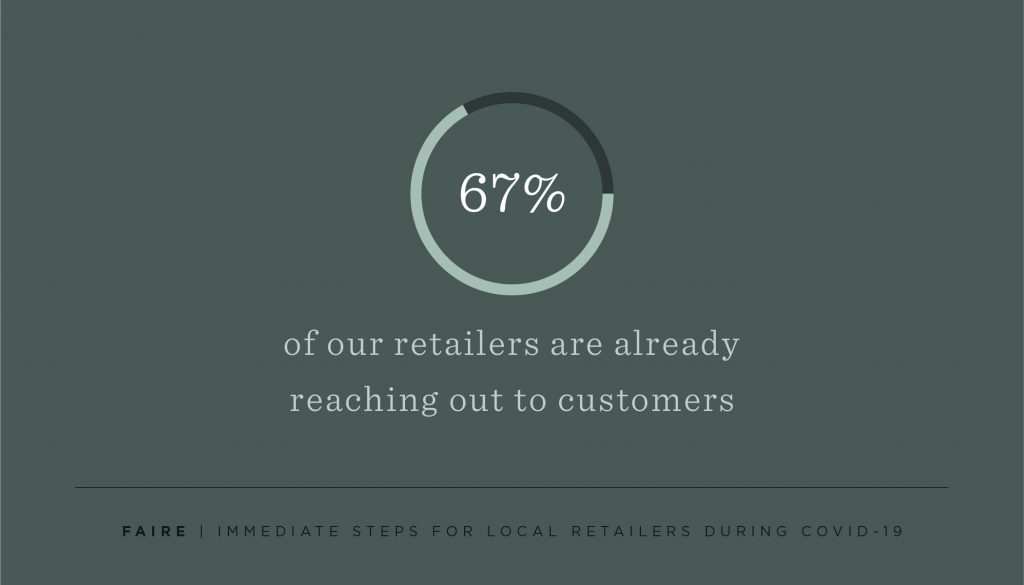
8. Bookmark these essential resources
At this time, global efforts are focused on lessening the spread and impact of this virus. The U.S. federal government is working closely with state, local, tribal, and territorial partners, as well as public health partners, to respond to this public health threat.
Trusted COVID-19 information:
- WHO: Getting Your Workplace Ready for COVID-19
- CDC: Interim Guidance for Businesses and Employers
- OSHA: OSHA Resources for Workers and Employees on COVID-19
- SBA: Small Business Guidance and Loan Information
- U.S. Chamber of Commerce: Combatting the Coronavirus
- U.S. Government: COVID-19 response
We’re here for you
Our team at Faire has been working hard over the last year to ensure that we’re prepared for volatility and can stand by our customers in the face of uncertainty. We will drive forward, continuing to build new products and provide support for you and your business during this time.
We’re committed to giving you the information you need to make important decisions about your business, and will provide more updates and trusted information as it becomes available.
In the meantime, join the conversation in our Facebook forum.
Survey methodology
This survey was conducted online within the United States by Faire from March 18-19, 2020, among 22,094 U.S. adults ages 18 and older. For complete survey methodology, including weighting variables and subgroup sample sizes, please contact press@faire.com.


